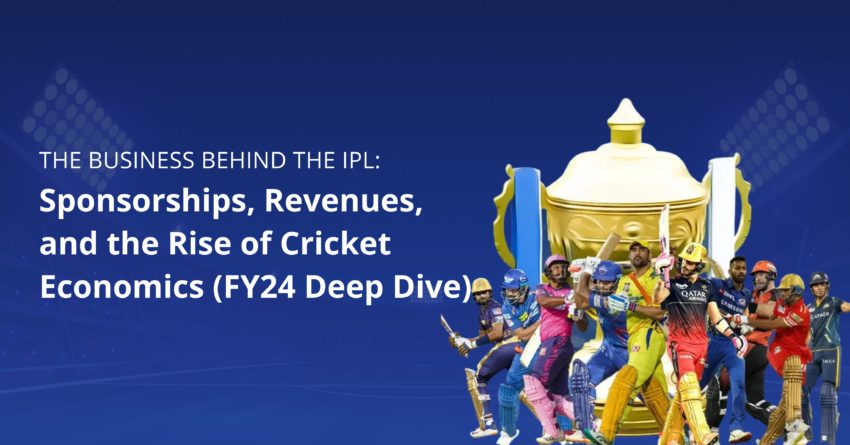When it comes to sporting events that blur the lines between entertainment and economics, the Indian Premier League (IPL) stands unmatched.
With rising valuations, blockbuster team acquisitions, and lucrative brand deals, the 2024 financial snapshot of IPL teams reveals an evolving commercial ecosystem fueled by aggressive sponsorships and central revenue rights.
Sponsorship Income: Who’s Winning the Brand Game?
The rise in sponsorships is no coincidence – it reflects the growing value of IPL as a marketing platform. Here’s how key teams performed over the last three years:
| Team | FY24 Sponsorship Income (₹ Cr) | YoY Change vs FY23 | % of Total Income (FY24) |
| RCB (Royal Challengers Bengaluru) | ₹123.7 Cr | ▲ +₹40.6 Cr | 19% |
| CSK (Chennai Super Kings) | ₹95.5 Cr | ▲ +₹17.7 Cr | 14% |
| DC (Delhi Capitals) | ₹99.3 Cr | ▲ +₹14.2 Cr | 13% |
| KKR (Kolkata Knight Riders) | ₹79.8 Cr | ▲ +₹23.5 Cr | 12% |
| RR (Rajasthan Royals) | ₹30.7 Cr | ▲ +₹3.7 Cr | 5% |
| LSG (Lucknow Super Giants) | ₹8.6 Cr | ▲ +₹0.5 Cr | 1% |
| MI (Mumbai Indians) | ₹7.3 Cr | ▼ -₹3.4 Cr | 1% |
RCB leads the pack with ₹123.7 Cr – one of the few franchises where sponsorships form a significant share (19%) of total income.
MI shows a sharp dip in sponsorship as a % of income (just 1%), indicating either consolidation of deals or revenue dependence on other sources like central rights.
Central Rights Revenue: The Backbone of IPL Team Earnings
The IPL’s central pool – comprising broadcast, streaming, and sponsorship rights – forms a major revenue source. Let’s look at its share:
| Team | Central Rights Revenue (₹ Cr) | % of Total Income |
| RR (Rajasthan Royals) | ₹553.6 Cr | 84% |
| DC (Delhi Capitals) | ₹579.3 Cr | 75% |
| MI (Mumbai Indians) | ₹525.8 Cr | 71% |
| CSK (Chennai Super Kings) | ₹479.2 Cr | 71% |
| RCB (Royal Challengers Bengaluru) | ₹421.8 Cr | 65% |
Most teams still rely heavily on central rights – especially RR, DC, and MI, where it constitutes more than 70% of total income.
Total Income Trends (FY22–FY24)
| Team | FY24 Income (₹ Cr) | FY23 | FY22 |
| GT (Gujarat Titans) | ₹776.6 Cr | ₹359.5 Cr | ₹205.8 Cr |
| DC (Delhi Capitals) | ₹768.2 Cr | ₹366.6 Cr | ₹374.6 Cr |
| MI (Mumbai Indians) | ₹737.0 Cr | ₹358.8 Cr | ₹322.3 Cr |
| CSK (Chennai Super Kings) | ₹676.4 Cr | ₹292.3 Cr | ₹349.1 Cr |
| RCB (Royal Challengers Bengaluru) | ₹649.5 Cr | ₹247.4 Cr | ₹313.5 Cr |
| KKR (Kolkata Knight Riders) | ₹664.1 Cr | ₹272.8 Cr | ₹315.6 Cr |
| RR (Rajasthan Royals) | ₹661.7 Cr | ₹301.9 Cr | ₹271.8 Cr |
| LSG (Lucknow Super Giants) | ₹695.4 Cr | ₹285.9 Cr | ₹431.8 Cr |
| KXIP (Punjab Kings) | ₹664.1 Cr | ₹275.6 Cr | ₹285.1 Cr |
GT (Gujarat Titans), despite being a newer entrant, tops FY24 revenue.
Older franchises like KKR and RR show muted YoY income growth compared to their newer counterparts.
Observations & Real-World Context
- Digital-first leagues: IPL has embraced platforms like JioHotstar for free streaming, increasing viewer base and brand interest.
- Brand spillover effect: Successful team brands (e.g., CSK, RCB) generate income beyond the field – from jersey deals to fan merch, and regional activations.
- Revenue ceiling ahead? Teams with low diversification may face revenue stagnation without innovation.
🔮 Final Takeaway
The IPL is no longer just cricket – it’s an ecosystem of entertainment, tech, media, and finance. Teams that:
- Diversify income (sponsorships, local deals)
- Build lifestyle brands (like RCB, CSK)
- Engage fans beyond the game
…are the ones that will stay ahead in the long run.

